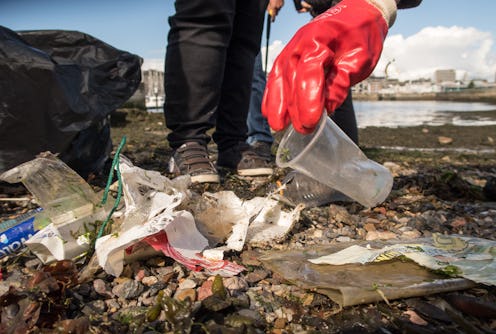Life
Balloons & 6 Other Plastic Items That Hurt The Environment More Than Straws

There's a growing movement across the U.S. to eliminate plastic straws in public venues like restaurants and cafés. While the uptick in straw bans and other measures is certainly a well-intentioned attempt to help Mother Earth, this kind of legislation has a few drawbacks. Many disability advocates have pointed out that straw bans don't take into account the needs of disabled people, for whom plastic straws are an important accessibility tool. Banning plastic straws would have a measurable, negative effect on disabled people — but some environmental advocates also note that it wouldn't really do that much for the environment, either, compared with banning plastic bags, balloons, or other single use plastic items.
If you’re able and willing to cut back on your plastic straw usage, that’s great. While the oft-cited statistic that Americans use 500 million straws per day has been called into question, there's no doubt that our reliance on difficult-to-recycle plastic straws has reached a breaking point. But there are items with far greater environmental impact than straws — that, critically, don't impact the needs of people with disabilities — whose use should be examined, too. Going strawless, or even using plastic straw alternatives, are not realistic or safe options for many disabled folks.
Our quest to save the planet can’t — and shouldn’t — be at anyone else's expense. Here are six other plastic items we can cut back on to help the environment.
1Fishing Gear
National Geographic reported this past March that the infamous "Great Pacific Garbage Patch" — the largest conglomerate of plastic pollution in our oceans located between Hawaii and California — is mostly made up of abandoned fishing gear. Despite this fact, much of the environmental efforts have not been poured into eliminating waste from fishing. As of March 22, the patch was at least 87,000 tons of plastic, and growing.
2Plastic Bags
As TakePart reported in 2016, a study published in the journal of Marine Biology found plastic bags were among the top twenty worst kinds of plastics in our sea, following right behind fishing gear. The National Oceanic and Atmospheric Administration (NOAA) reported in 2014 that plastic bags are the most commonly ingested type of plastic litter by seas turtles. So whether you make the switch to reusable food storage, produce bags or both, eliminating your use of plastic bags (and calling on local businesses to switch to more sustainable practices) is a simple way to make a dent in your environmental footprint.
3Bottle Caps
According to the Project AWARE Foundation, bottle caps are among the top five plastic ocean pollutants, and they constitute a huge choking hazard to marine life and sea birds. If you have the funds to invest in a reusable, BPA-free water bottle that you can take on trips and outings, that's a better alternative to buying one-time use plastic water or soda bottles.
4Cigarette Butts
According to a study published in the BMJ Journal Tobacco Control, cigarette butts are the "single most commonly collected waste item found each year on beach clean-ups." Not to mention, the research also estimated cigarette butt make up somewhere between 25 to 50 percent of roadside litter. The majority of cigarettes contain filters made in part of cellulose acetate, which is a kind of plastic that then finds its way into our waterways. Trying to kick a smoking habit can be hard AF, but, is worth it if you're trying to lead a healthier lifestyle and help the environment.
5Balloons
Balloons may be a fun, festive addition to parties, but let's face it: They are totally an unnecessary item, on top of being a huge source of pollution. The nonprofit organization Balloons Blow reported that, "In 2012, balloons were the most common debris seen while aboard whale watching vessels in Stellwagen Bank National Marine Sanctuary from April to October." Additionally, in 2015, the U.S. Fish and Wildlife Service released a PSA that emphasized the devastating impact that releasing balloons has on birds, as well as marine life. Try jazzing up your party with recyclable or compostable paper decorations instead.
6Food Wrappers
I love mini candy bars as much as the next person, but according to Project AWARE's 2017 Annual Report — which includes statistics gathered through their program Dive Against Debris — plastic food wrappers made up 5.03 percent of the pollution they found. (Plastic straws, on the other hand, didn't make it into the top ten on this list.)
While any individual attempt to cut back on plastic items and other pollutants that hurt the ocean is so important, simple bans of certain types of plastic is not the be-all, end-all of environmentalism: "Rather than chase the false promises of a product ban, cities should consider taking actionable steps that are supported by the data. For one, cities should implement targeted enforcement of existing litter ordinances by determining where larger amounts of trash collect and then observing and tracing their sources," wrote Steven Stein, a principal of the Environmental Resources Group and environmental scientist, for the Los Angeles Times in 2017. "Additionally, cities should implement focused education programs for addressing litter, particularly in known high-litter locations."
In order to be effective, environmental activism must be inclusive of all communities, and aware of valid accessibility needs. If we all do what we can — whether that's opting to use reusable plastics, lobbying congress for environmental protections, or volunteering at a beach cleanup — we can save the planet together.